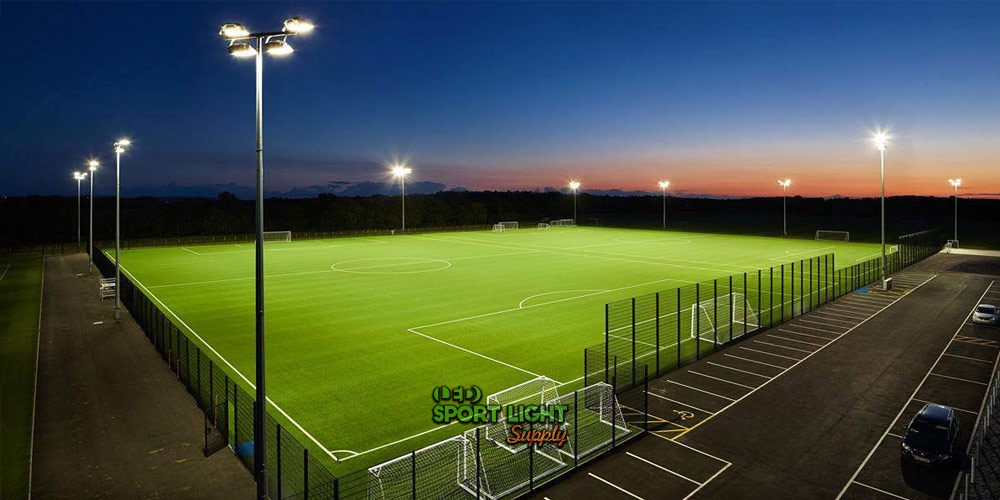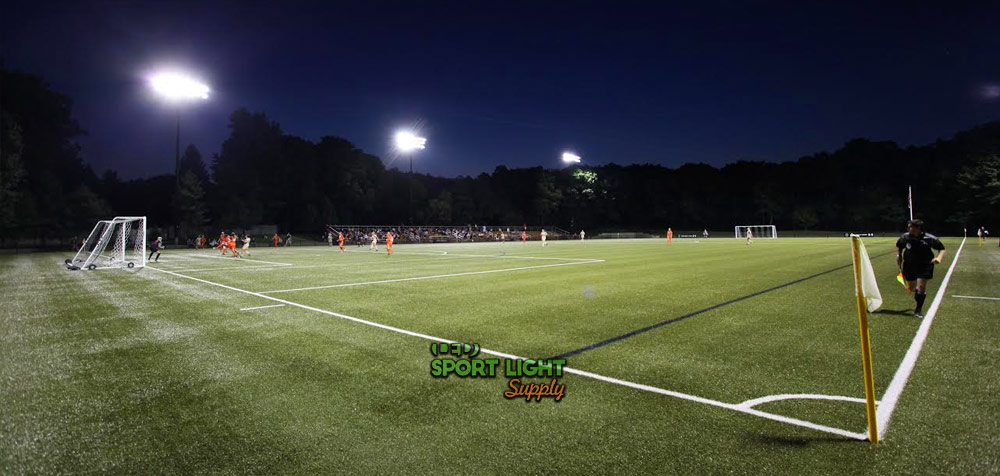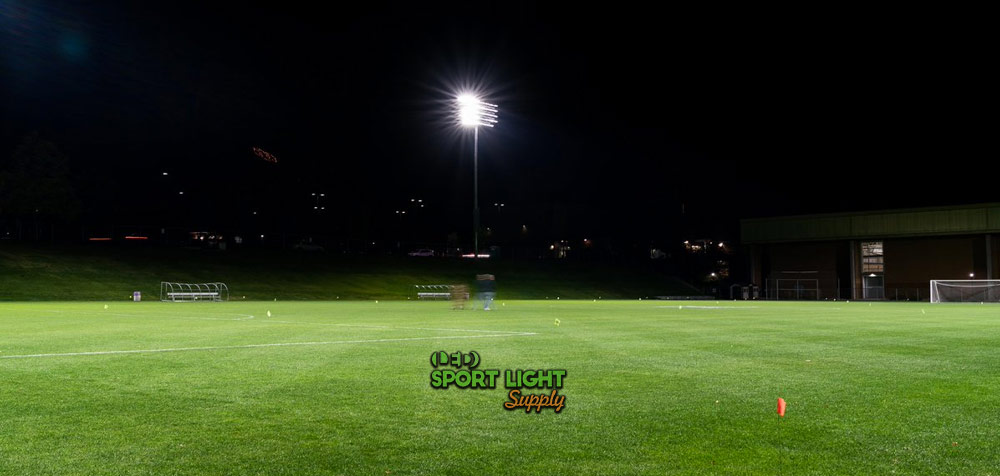Most people envision a well-lit soccer stadium and assume that the electricity powering it comes from the national grid. However, high-powered solar LED sports lighting solutions are a viable and effective alternative. Sunlight can serve as an ideal source for illuminating soccer fields while keeping energy costs low. Initially, LED lighting for football fields was a sophisticated option for practice pitches, but it has now become increasingly widespread.
In this guide, we will explore the essentials of solar-powered stadium lights. We will begin by explaining what solar stadium lights are and how they function. Next, we’ll discuss practical applications for using them in real stadiums. A dedicated section will highlight the main advantages of solar LED flood lights. We will also address some common questions that you might have about these innovative lighting solutions.
Table of Contents
ToggleWhat is Solar Stadium Lighting?
Solar stadium lighting is an innovative solution that harnesses solar power to illuminate sports venues. This system integrates LED lights with a battery storage component to provide efficient and sustainable lighting for various applications, including soccer practices and matches. A typical solar LED light setup includes a lighting fixture, a light pole, solar panels, and either a trailer or a base.
Key Components of Solar Stadium Lighting
Professional-grade solar stadium lighting models often feature:
| Component | Description |
|---|---|
| Generator | Provides backup power for mobile light towers. |
| Special Optic Lenses | Designed with anti-glare technology to enhance visibility. |
| Anti-Flickering Solutions | Reduces light flicker to improve visual comfort. |
| Remote Control | Allows for convenient adjustment of lighting settings. |
| High-Quality LED Chips | Ensures bright and efficient illumination. |
How Does Solar Stadium Lighting Work?

Solar stadium lights operate by utilizing sunlight to generate electricity. The process begins with solar panels capturing solar energy. This energy is then converted into electricity, which is stored in a battery. The stored electricity powers the LED lights, ensuring that they can illuminate the soccer field or practice pitch whenever needed.
The LED diodes within the lighting fixtures function similarly to traditional lighting, but with the added benefit of solar power. This hybrid system not only provides high-output lighting but also reduces the reliance on conventional electricity sources.
Can We Use High-Powered Solar Lighting in Soccer Fields and Football Stadiums?

The answer is a resounding yes. High-powered solar lighting is indeed a viable option for soccer fields and football stadiums today.
Benefits for Amateur Soccer Clubs
Amateur soccer clubs can significantly reduce their electricity costs by adopting solar lighting technology. During the warmer seasons, football matches are often scheduled at various times of the day, with only special events typically extending into the evening. This makes solar-powered stadium lights an especially practical solution for such venues.
Efficiency in Different Seasons
Modern batteries used in solar lighting systems are highly reliable. In winter, the hybrid power system helps to further decrease electricity expenses. Despite shorter daylight hours during the colder months, the system can still provide approximately six hours of high-powered lighting each day. Solar panels have ample time to recharge the battery between soccer practices, ensuring that the lighting remains effective.
Smart Features for Convenience
Many solar-powered lighting models come equipped with practical features such as light sensors. These sensors enable automatic switching of the lights at sunrise and sunset, reducing the need for manual adjustments. This functionality ensures that the lights operate efficiently without requiring constant monitoring or specialized training. Consequently, the system optimizes energy consumption while offering convenience and ease of use.
Advantages of Using Solar LED Flood Lights for Stadiums
Reducing Running Costs

One of the most significant benefits of solar LED flood lights is the reduction in electricity costs. Sunlight, being a renewable and infinite resource, makes solar power a valuable investment for football associations.
Consider that renowned stadiums, such as those in the Premier League, can consume over 25,000 kWh per match. For FIFA World Cup stadiums, lighting must meet stringent requirements for spectators, players, and broadcasters, resulting in high electricity bills. Solar LED sports lights can help lower these expenses, as they directly address the need for cost-effective lighting solutions.
Lower Installation Costs
The installation of solar football lights is notably practical. Solar lights operate independently, reducing the need for extensive wiring. Additionally, many models come with light sensors that automate the lighting process, allowing them to turn on and off at sunrise and sunset without manual supervision. This is particularly useful for areas such as entrances and parking lots.
The cost of installation varies depending on factors such as the power of the solar panels. Generally, as the installed power increases, the cost per kW decreases slightly. There may also be promotions or national incentives available to offset installation costs. When choosing a brand, it’s essential to consider the company’s market presence and availability of emergency repair services to ensure timely support.
Longer Lifespan of LEDs
High-quality LED stadium lights offer a long lifespan, often exceeding 150,000 hours. The technology behind LEDs continues to advance, with improvements in heatsinks and overall design. An LED lighting system includes components such as:
- Power supply
- Control electronics
- Heat transfer elements
- Optical lens
- Protection elements
- Aesthetic features
Each of these components contributes to the overall quality and longevity of the LED lights. With advancements in power electronics and renewable energy integration, stadium LED lights provide an efficient and durable lighting solution.
Dusk-to-Dawn Function
Many football venues are located near urban areas or as part of larger facilities. The dusk-to-dawn function of solar LED lights can be highly beneficial, providing continuous illumination for security, emergency exits, or public service.
Depending on the sensor type, options may include:
| Sensor Type | Function |
|---|---|
| Passive Infrared | Detects occupancy based on infrared spectrum changes. |
| Ultrasonic | Emits inaudible sound waves to detect changes in reflected sound. |
| Acoustic Wave | Detects sound waves for complex setups. |
These sensors help automate lighting, ensuring that the lights operate efficiently without manual programming.
Advanced Control Systems
Solar LED flood lights often come with advanced control systems. For example, many high-powered models include remote control functionality via smartphone apps. This allows users to adjust brightness, color temperature, and other settings wirelessly.
Other lighting control systems include:
| System | Description |
|---|---|
| DALI | Manages automated lighting with standard control, suitable for static setups. |
| DMX | Offers advanced lighting effects, commonly used in concerts and shows. |
These systems provide flexibility in managing stadium lighting, enhancing user convenience and control.
Minimizing Disruptions During Matches
Power interruptions can disrupt matches, causing delays and frustration. Solar LED lights, powered by a combination of solar energy and battery storage, minimize the risk of such disruptions. The hybrid system ensures continuous lighting, even if there are temporary issues with the national power grid. Additionally, solar LED lights require minimal maintenance, with periodic checks to ensure optimal performance.
Solar Soccer Stadium Lighting Q&A
How Long Do Solar Stadium Lights Last?
Solar stadium lights typically have a lifespan ranging from 4 to 10 years. The primary factor influencing this duration is the quality of the batteries, as these components tend to degrade over time due to continuous recharging. While the lighting system itself can last for decades, the batteries have a more limited lifespan.
The frequency of use also impacts battery life. If the lights are used frequently to illuminate the practice pitch or soccer field, the batteries will experience more wear and tear. Additionally, maintaining the cleanliness of the solar panels is crucial. Although solar stadium lights require minimal maintenance, keeping the panels free from debris and bird droppings can help extend their overall lifespan.
How Long Does It Take to Charge the Solar LED Stadium Lights?
Charging time for solar LED stadium lights typically ranges from 4 to 10 hours of direct sunlight. This variation depends on several factors, including the design of the lighting system and the placement of the solar panels. Proper positioning of the panels is essential for optimal charging efficiency. Environmental conditions, such as weather, also affect charging times. For instance, during summer, the charging process may take less time due to more favorable weather conditions.
Do Solar Soccer Field Lights Charge on a Cloudy Day?
Solar field lights do generate electricity on cloudy days, but their efficiency is reduced compared to clear days. On average, photovoltaic panels produce only 10-25% of their nominal capacity under cloudy conditions. The exact efficiency varies depending on the cloud density and the type of solar panel used. Some panels are designed to perform better in diffused light conditions.
What Is the Brightest Solar Stadium Flood Light?
The most advanced solar stadium flood lights can have a power consumption of up to 1500 watts, providing approximately 250,000 lumens. This level of brightness is comparable to sunlight, with a luminous efficacy of about 166 lumens per watt. High-power LED lights often come with features such as:
- Dimmable options
- Certifications for quality and safety
- A long lifespan
- Customization options for precise beam angles
These features ensure that the lighting system not only meets the high standards required for stadiums but also enhances the overall experience for players and spectators alike.
Conclusion
Solar LED flood lights offer a range of benefits for stadiums, including significant cost savings, lower installation expenses, and advanced features that enhance performance. Their long lifespan and efficient operation under varying conditions make them a valuable investment for both amateur and professional sports venues. By utilizing solar energy, stadiums can reduce their reliance on traditional power sources, contributing to both economic and environmental sustainability. As technology continues to advance, solar lighting solutions will likely become even more integral to modern sports facilities.
